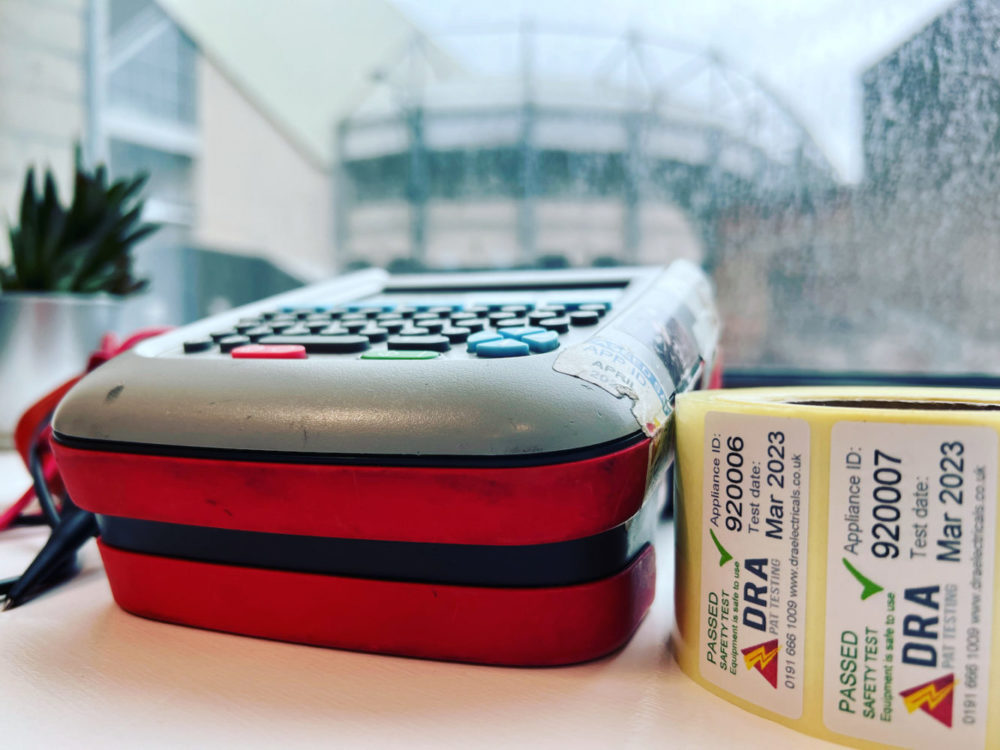PAT Testing Frequency – how often PAT testing needs doing
There was a time when businesses got their electrical equipment checked to make sure it was safe, and then they rechecked after a desired period of time based on the guidance of the inspector. This made perfect sense.
Then over time it became normal practice to get all appliances tested every year. This also made perfect sense because doing so was considered an appropriate amount of time between checks to ensure appliances stayed safe or to capture any faults that had developed, and not too long a period where dangers could arise without being found.
This period of time also became a national standard – insurance companies preferred it, fire officers preferred it, health and safety preferred it.
It was simple, and it happened everywhere.
The beauty of it was that a business could get a local PAT tester to visit their workplace, inspect all their appliances, do running repairs, test items that needed testing and provide them with a comprehensive report that listed all appliances, and the test results. This was exactly what everyone needed to comply with the likes of the Health and Safety At Work Act 1974, Electricity at Work Regulations 1989 and so on.
When an accident occurred and the HSE got involved, or an insurance investigator, they’d ask – “when did you last check this appliance was safe?” And they’d be able to show them their PAT Certificate, which showed the appliance was checked within the last 12 months, and the assessor would be happy. Box ticked, pay-out rubber stamped. (*there’s a bit more to it than this but you get the gist)
PAT testing was carried out annually for years – it was never an issue, it was cost effective as it didn’t really cost that much and the beauty of it was it gave a business everything they needed.
Then in 2011 the Government got involved and the Lofted Report was commissioned. And then it all got very confusing.
The report was written in reference to all kinds of Health and Safety systems, but what was pounced on more by the press than anything, was the portable appliance testing. Unfortunately many people don’t hold it in high regard – these people have not suffered an electric shock or had their business wiped out by an electrical fire.
The report suggested that not all items of electrical equipment needed testing every year; some appliances didn’t need testing as often and some needed it doing more often, and the messages put out ranged from the sensible to the ridiculous.
The HSE, and the IET put out their guidance on how often appliances should be tested, and everyone was suddenly talking about their PAT testing frequency.
Computers should be tested this often, power leads this often, kettles this often, tools this often, vacuum cleaners this often and all of a sudden it was very confusing and very expensive. Before this a business had got the tester in to test 300 items every year and it cost them £500.00. Now they needed to get them in every 3 years for the stationery IT equipment, every 5 for other stationery equipment, every 6 months for the vacuum cleaner, every year for the kitchen appliances, and so on, and each time there was a callout charge, and more and more paperwork and before anyone knew it a very simple system had got very complicated, and expensive.
To top it all off, because things were now on different frequencies you needed to show how you came up with that frequency, and how that frequency ensured safety, because despite guidance being available, it was just guidance and not a legal timeframe.
So now you have to do a risk assessment, and not just one; many. A fire risk assessment, an assessment of the risk of use, and assessment of the environment, an assessment of different types of appliance, and each one costs money to produce. Suddenly that £500 PAT test is costing £2000 in assessor fees before you start doing the appliance tests.
The Lofsted report was talked about (argued) for years, and nobody could come up with a clear justification about whether it had improved the system.
Aware of all this confusion in 2020 guidance started to change, retest tables were pulled from guidance documents, and the message simply was – get your appliances checked regularly enough to ensure they stay safe to use, and to prevent danger.
So what is an acceptable time period to prevent danger?
Nobody knows, because every workplace is different, users are different and you have to do your risk assessments to determine that.
Or, you simply get your PAT testing done in full every year, or a period proportionate to the risk of the use and environment. If your PAT Testing company is anywhere near as good at doing their job as you are doing yours, they’ll be able to give you some great advice on this.
You see, annual PAT tests are proven to prevent danger, and having done our job for as long as we have we know that this is the best frequency to work with.
We can guide you on your PAT Testing Frequency, it may be that we don’t have to test everything every year, such as if your desktop computers are secured with ‘arms’ and cables are tidy in trunking, straight into floor boxes, but not everyone is the same and it’s impossible to determine without first seeing your site, and testing all your equipment initially.
If your site is low risk, like an office based business, we recommend testing everything initially, then again in 12 months. From that we can assess the changes and recommend a new retest period, which could be keep it the same, or extend the term between tests for some or all equipment.
However, in high risk environments we may recommend more frequent tests – on a building sites tools should be tested every 3 months!
Either way, whatever we recommend, the final decision on how you proceed is yours, because as a business owner or appointed duty holder, if an accident occurs it is your responsibility, and in turn, your responsibility for preventing that accident, so only you can decide what maintenance and how often is most suitable for your workplace.
The best advice we can give you right now, is stop trying to second guess it, let us come in to test all your equipment and assess your workplace, and from that we will give you our recommendations. After that it’s up to you how you proceed.
A Rough Guide to PAT Testing Frequency
The table below is an example of how you could consider the risk of electrical equipment in different working environments. It is meant as an example not a recommendation. A recommendation for your business cannot be made without us seeing it.

Need help with your PAT Testing Frequency?
If you hadn’t already guessed it, how often you need to get PAT testing done is a grey area. Mainly because you don’t ever need to get PAT testing done; you need to maintain safe electrical equipment and collate records to support that. PAT testing Certificates are a great way to achieve this.
If you’re totally confused, or you need some help why don’t we set up a meeting? I can come to your workplace so we can talk through your options. Or just send me an email to explain your situation and I’ll get back to you with my thoughts. There’s no obligation.
Get in touch with Richard, email [email protected]

More PAT Testing Frequency Information
Everything you ever wanted to know about how often PAT testing should be done is included here.
Duty Holders, or managers of premises and businesses, are expected to know their legal responsibilities; although what is expected and what is reality are two different things. “As a business owner I know how hard it is to know everything, which is why I utilise experts who can guide me, just as you can with us for maintaining safe electrical equipment.”
You should understand and apply legislation and assess the risks in respect of equipment that you are responsible for. You have a legal responsibility to ensure that equipment in your charge is safe.
How often should you get PAT testing done?
As often as is necessary to maintain safe equipment and prevent danger.
From our experience, from the amount of repairs we come across, from a fire prevention and safety perspective, we and many other safety representatives prefer to see businesses get their electrical equipment inspected every year – insurance companies prefer it, there is more chance of faults being found and fixed before they become a problem, checking equipment this regularly keeps on top of safety.
However, we also understand that you may not want the disruption of annual tests, or the expense of it, so prefer to look at ways to maintain a safe workplace with less frequent checks. If you don’t want to do it every year and your workplace is low risk, like a clean and tidy office, then you may be ok doing it every 2 or even 3 or 4 years. As long as you can justify it in a risk assessment should you ever need it.
Don’t extend it to longer than that without a watertight risk assessment.
PAT Testing frequency is dependent on :
- The type of electrical appliance
- The use of the electrical appliance
- The environment the appliance is being used in
- The user of the appliance
- The risk of the appliance getting damaged
After taking all these factors into consideration, basically be carrying out a risk assessment, you can decide on your PAT Testing frequency (or how often PAT testing needs doing).
How often should you PAT test electrical equipment?
As discussed briefly above, PAT testing should be repeated as often as is necessary to reduce or remove the risk of an accident occurring. This could be anything from 3-monthly for power tools on a building site to every 5 years for a well maintained server system in an office building. There are many factors to consider when undertaking a risk assessment for electrical equipment, but in doing so you can put in place a suitable PAT testing frequency to carry forward in your business.
You should make your PAT testing company aware of your preferred frequencies for the different types of equipment, so they can help you maintain them, and also so they can feedback to you if any updates are needed based on test results.
Is annual PAT Testing necessary?
Whilst it is no secret that too many businesses get annual PAT testing, it is necessary for some to do it, and for others, it is often the cheapest and easiest option available so they choose to do it.
The PAT industry prefers you to get annual PAT testing carried out, simply because it is good for business, but also because experience shows us that annual testing usually leads to safer workplaces.
But if you want you can do a risk assessment instead which usually takes up a lot of time and can be a lot more expensive than an annual PAT test.
We are however, very happy to discuss your options with you, and show you where we can save you money by carrying out your electrical testing more efficiently.
What you need to do to maintain safe electrical equipment
It is important that you as a business owner or duty holder for the company are aware of what you are expected to do, to maintain safety against electrical risks.
This applies in principle to anyone managing or running a business of any kind, and in part, every employee is also responsible – we are all responsible for electrical safety/
You know electricity kills right? Of course you do, but do you know keeping people safe from dodgy electrical equipment is actually really easy to do.
1. Check your equipment before you use it
2. Get us in to PAT test it as often as is necessary to reduce the risks
That’s right, if you check your electrical equipment before you use it, and you get it PAT tested on a regular basis, the chances of an electrical accident occurring, dramatically reduce, possible even are removed altogether.
To remove the risk of an electrical accident, the best way, is to get PAT testing done as often as possible. Every year is widely regarding as an acceptable period between checks, but more often, or less frequent may be better for your equipment; some electrical appliances can get easily damaged, and others are less likely to, so this means there is no one size fits all option.
It’s actually widely considered, though, that in most cases, if you get equipment tested every year, and your PAT tester looks at more than just your appliances, and you do your own visual checks in-between, then you should be able to maintain a safe workplace.
Insurance companies tend to prefer annual frequencies, as do many regulatory bodies and it is considered best practice in most workplaces (except the really dirty or dangerous places).
The HSE on the other hand, don’t like to get drawn into telling you what to do so they advise you do a risk assessment.
Contrary to popular belief, not all appliances need testing, and not all need testing every year, but ALL appliances do require regular inspections by a competent, experienced person.
If your PAT tester doesn’t get his screwdriver out, and doesn’t open plugs to check inside, he is not doing what you are paying for.
You need to assess the risks
So HSE guidance recommends a risk assessment be carried out to determine what preventative maintenance measures need to be carried out, and how often that needs doing.
In most offices for example a risk assessment will say that most of your equipment is low risk – it sits on a desk for years and never moves, so the chances of a fault are slim, so you could do a test every 4 years with an inspection at 2 years. That would be acceptable. Some other equipment, that may move more often will need checking more often, so that could be done every 1 or 2 years. You may have field engineers with tools in their vans; they’ll need doing more often than that, probably. However, your insurer may expect an annual PAT test on your IT equipment, so check.
Your insurer will also want to see a risk assessment in the event of an investigation, so if you choose anything other than annual – do a risk assessment, in fact, do one anyway.
If you manage a building site however, then you need equipment checking a lot more often. Power tools get easily damaged, they get wet, and they’re prone to damage so they need a test every 3 months, and a monthly inspection! We can do the 3-monthly part but it may be worth training someone in-house to do the inspection.
Thorough Visual Inspections and PAT tests are needed
When we do our PAT tests, we inspect every appliance thoroughly; if there is a fault or damage to the plug, or cable, we repair it automatically, (if it’s the standard 13amp type plug this is done for free); if the fuse is wrong we change it, and if the plug is beyond repair we’ll replace that too, also for free.
If the cable is damaged, we’ll cut it back to a safe place and reattach the plug. If the cable needs replacing, if we can do it, we’ll quote you for that task.
If the appliance is beyond repair by us we will fail it; it’s possible a specialist engineer may be able to repair it, and if so, we will advise that action.
If we come across any other safety issues, such as overloaded extensions, and appliances being used incorrectly, we’ll report that to you and guide you what to do.
On completion we will send you your PAT Testing Certificate Report which logs all appliances and confirms they are safe, or if not, what to do with them.

